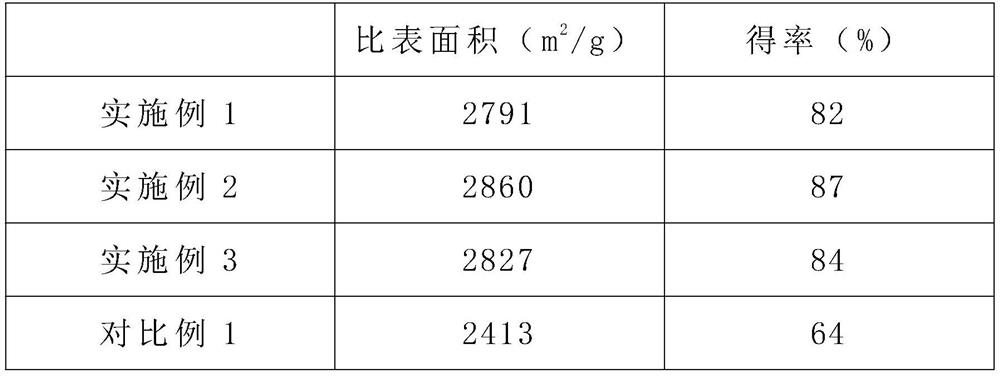A processing technology for increasing the specific surface area of activated carbon through baking pretreatment
A technology of specific surface area and processing technology, applied in the field of processing technology of baking pretreatment to increase the specific surface area of activated carbon, can solve the problems of reduced yield of activated carbon, easy bond breakage, condensation, environmental pollution, etc., to improve the specific surface area and increase the degree of polymerization. , the effect of improving quality
- Summary
- Abstract
- Description
- Claims
- Application Information
AI Technical Summary
Problems solved by technology
Method used
Image
Examples
Embodiment 1
[0033] Take lignin and place it in a tube furnace, heat it up to 180°C at a heating rate of 5°C / min, and keep it at this temperature for 30 minutes. The condensable liquid in the gas generated by baking is separated by indirect cooling with water to obtain product A;
[0034] After the previous step, stop heating and cool the product A to room temperature, take pure water to dissolve the activator to prepare an activator solution, and mix it with the product A in proportion according to the ratio of product A: activator mass ratio of 1:1 to prepare Obtain product B, wherein activator is potassium hydroxide;
[0035] Take the product B obtained in the previous step and place it in an oven, dry it at 100°C for 4 hours, transfer it to a tube furnace, and raise the temperature to 885°C at a rate of 2°C / min under the protection of nitrogen or other inert gases , heat preservation and activation for 30 minutes to obtain product C;
[0036] The product C obtained in the previous ste...
Embodiment 2
[0038] Take lignin and place it in a tube furnace, heat it up to 240°C at a heating rate of 12°C / min, and keep it at this temperature for 75min, and the condensable liquid in the gas generated by roasting is separated by indirect cooling with water to obtain product A;
[0039] After the previous step, stop heating and cool the product A to room temperature, dissolve the activator in pure water to prepare an activator solution, and mix it with the product A in proportion according to the ratio of product A: activator mass ratio of 2:5 to prepare Obtain product B, wherein activator is sodium hydroxide;
[0040] Take the product B obtained in the previous step and place it in an oven, dry it at 105°C for 5 hours, transfer it to a tube furnace, and raise the temperature to 900°C at a rate of 6°C / min under the protection of nitrogen or other inert gases , heat preservation and activation for 60min to obtain product C;
[0041]The product C obtained in the previous step was cooled...
Embodiment 3
[0043] Take lignin and place it in a tube furnace, heat it up to 300°C at a heating rate of 20°C / min, and keep it at this temperature for 120 minutes. The condensable liquid in the gas generated by baking is separated by indirect cooling with water to obtain product A;
[0044] After the previous step, stop heating and cool the product A to room temperature, dissolve the activator in pure water to prepare an activator solution, and mix it with the product A in proportion according to the ratio of product A: activator mass ratio of 1:4 to prepare Obtain product B, wherein activator is the mixture of potassium hydroxide and sodium hydroxide;
[0045] Take the product B obtained in the previous step and place it in an oven, dry it at 110°C for 6 hours, transfer it to a tube furnace, and raise the temperature to 915°C at a rate of 10°C / min under the protection of nitrogen or other inert gases , heat preservation and activation for 90min to obtain product C;
[0046] The product C...
PUM
 Login to View More
Login to View More Abstract
Description
Claims
Application Information
 Login to View More
Login to View More - R&D
- Intellectual Property
- Life Sciences
- Materials
- Tech Scout
- Unparalleled Data Quality
- Higher Quality Content
- 60% Fewer Hallucinations
Browse by: Latest US Patents, China's latest patents, Technical Efficacy Thesaurus, Application Domain, Technology Topic, Popular Technical Reports.
© 2025 PatSnap. All rights reserved.Legal|Privacy policy|Modern Slavery Act Transparency Statement|Sitemap|About US| Contact US: help@patsnap.com


